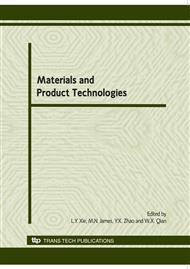p.454
p.459
p.464
p.468
p.474
p.479
p.487
p.492
p.497
Residual Strength Degradation Model for Low-Alloy Steel in High Cycle Fatigue Load
Abstract:
Residual strength degradation of 35CrMo alloy steel is investigated experimentally and theoretically in this paper. The experimental results were obtained by high-frequency fatigue testing machine and electro-hydraulic servo testing machine at room temperature. The experimental results showed the true tensile strength under static load and the residual strength under different cycle ratio, respectively. An exponential degradation model was proposed relating the initial strength, residual strength to the applied fatigue cycles and the constant amplitude stress. The residual strength distribution was described using three-parameter Weibull probability density function. The mathematical software MatLab was used for parameter estimation. Finally, the distribution function and failure probability density function of the residual strength was received, which was significant in fatigue reliability.
Info:
Periodical:
Pages:
474-478
Citation:
Online since:
June 2010
Authors:
Price:
Сopyright:
© 2010 Trans Tech Publications Ltd. All Rights Reserved
Share:
Citation:


